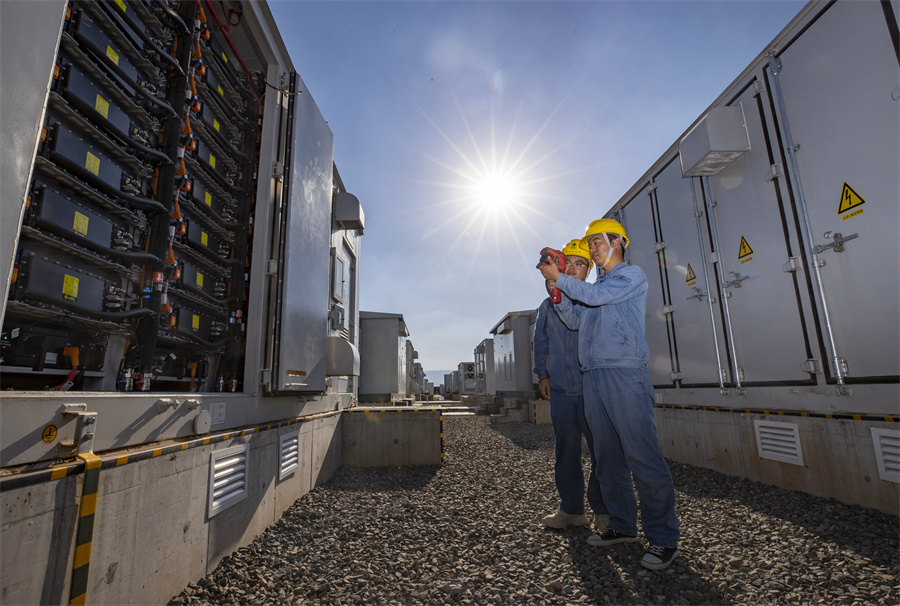
Workers carry out safety checks on electrical equipment in Wuzhong, Ningxia Hui autonomous region, in August. [Photo/Xinhua]
NANJING — In the eastern Chinese coastal county of Rudong, Jiangsu province, a 35-storey-high steel structure houses around 1,000 25-metric-ton gravity blocks that are lifted to store surplus renewable energy and lowered to produce electricity during peak demand.
Once fully completed, there will be a total of 12,000 gravity blocks, capable of generating 100,000 kilowatt-hours of electricity in just four hours.
The demonstration project is an example of China's burgeoning energy storage economy. Building on its leadership in electric vehicles, lithium batteries and solar panels, China is now poised to unlock a new economic growth frontier in new-type energy storage.
The rapid expansion of clean energy capacity in China has presented the key challenge of green energy storage, which has prompted a surge of innovative solutions.
China's installed capacity of new-type energy storage exceeded that of pumped storage for the first time at the end of 2024, according to a recent data release by China Energy Storage Alliance.
New-type energy storage has been highlighted in many regional industrial plans, and its value target by 2025 has exceeded 3 trillion yuan ($412.2 billion), said CNESA.
Foreign investors are also eyeing the vast potential of the market. At the end of 2024, US automaker Tesla's Shanghai energy storage Megafactory commenced trial production of its Megapack batteries. This new plant, the first of its kind that Tesla has built outside the United States, is expected to start full-scale mass production in the first quarter of this year.
Megapack is an electrochemical energy storage device that uses lithium batteries, a dominant technical route in the new-type energy storage industry. Tesla's vice-president Tao Lin noted that China offers a complete industrial chain, huge market potential and a production and business environment crucial for enterprise growth.
Chinese engineers are finding ways to store clean energy's abundant output. Besides gravitational energy storage, which stores electricity at elevated levels, they are exploring a multitude of ingenious energy storage solutions and constructing many large projects.
In the eastern Chinese city of Changzhou, Jiangsu, air compressed to over 120 atmospheres in salt caverns 1,000 meters underground is used for energy storage. The heat generated is transferred to thermal oil and then the electricity is regenerated on command.
This storage factory, which started operation in May 2022, has saved 40,000 tons of standard coal and reduces carbon dioxide emissions by over 150,000 tons annually.
Magnetic flywheel
On Jan 2, the world's largest single-unit magnetic levitation flywheel energy storage project was connected to the grid and began continuous operation in Penglai, Shandong province. During energy storage, external electrical energy propels the flywheel rotor to spin faster, thereby storing energy as kinetic energy.
Hydrogen
China's largest offshore photovoltaic-hydrogen-storage project in Rudong also began generating electricity in January. In this project, solar power is used for seawater electrolysis to produce hydrogen, which is utilized for electricity generation during peak demand.
Sodium-ion
In June 2024, a 100-megawatt-hour sodium-ion energy storage project began operation in Hubei province, representing the first large-scale commercial use of sodium-ion energy storage globally. This technology has advantages over lithium-ion batteries, such as lower raw material costs, higher safety, better low-temperature performance and longer cycles life.
Flow cell
In December, China's first 100-megawatt all-vanadium redox flow battery energy storage station in a cold region began operation in Jilin province, and is expected to consume 300 million kWh of new energy annually.
Supercapacitor
Also in December, a supercapacitor-lithium battery hybrid energy storage system began commercial operation in Shanxi province, becoming the world's largest such system.
As the domestic market becomes increasingly competitive, Chinese energy storage firms are quickening their pace of overseas expansion, especially in emerging markets.
Sungrow Power Supply signed a large energy storage project with Saudi Arabian company Algihaz in July which is expected to become fully operational this year.
Last year, this Hefei, Anhui province-based company signed agreements with Philippine company Citicore and the UK's Fidra Energy. Citicore's 1.5 GWh order is the largest in Southeast Asia, while Fidra Energy's 4.4 GWh order breaks the European record.
Chinese companies such as Huawei, Envision Energy, CORNEX and Sunwoda have each secured major energy storage contracts in the Philippines, South Africa, Italy and Australia, respectively.
"Chinese enterprises going global boast high brand recognition, swift market response and robust comprehensive competitiveness," said Sun Chuanwang, a professor at the China Center for Energy Economics Research at Xiamen University.
Xinhua